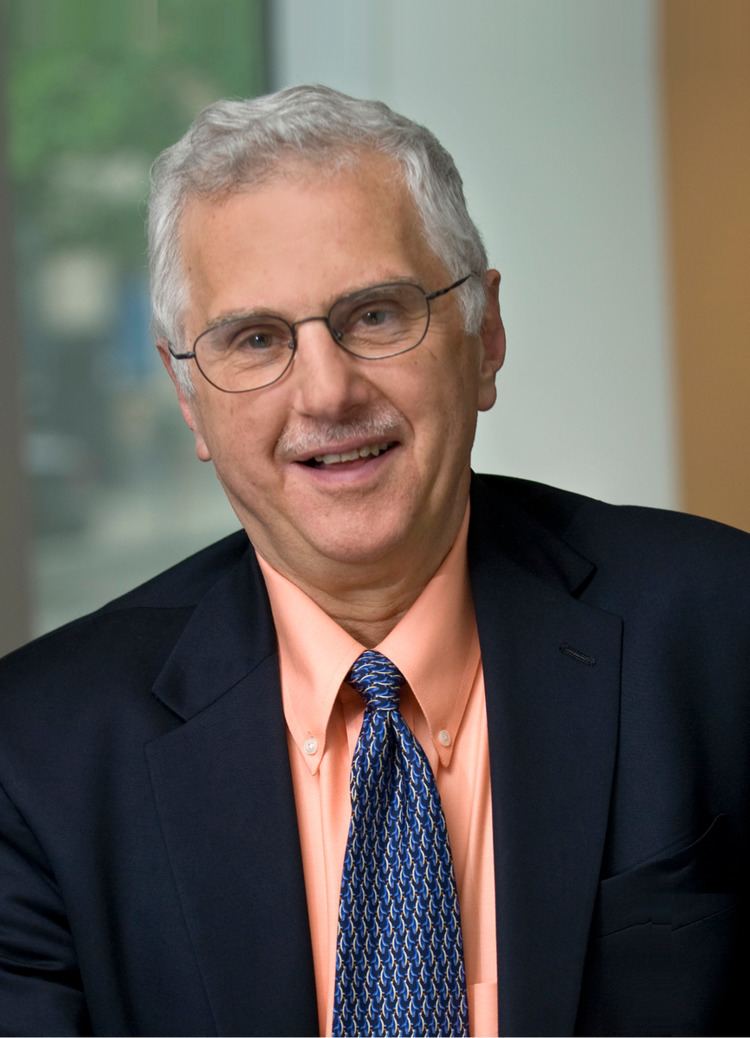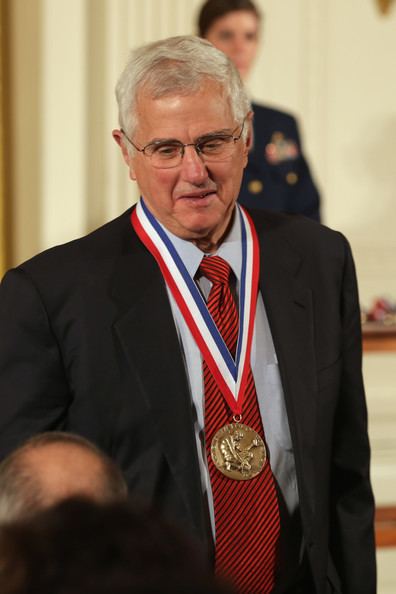Nationality American Name Bruce Alberts | Role Biochemist | |
 | ||
Born April 14, 1938 (age 87) Chicago, Illinois, United States ( 1938-04-14 ) Fields BiochemistryBiophysics Institutions Harvard UniversityUniversity of GenevaPrinceton UniversityNational Academy of SciencesUCSFScience (journal) Thesis Characterization of Naturally Occurring, Cross-Linked Fraction of Deoxyribonucleic Acid (1966) Notable awards NAS Award in Molecular Biology (1975)Commander of the Order of the British Empire (2005)Vannevar Bush Award (2010)National Medal of Science (2014) Known for Molecular Biology of the Cell Books Molecular Biology of the Cell Awards Gairdner Foundation International Award Similar People Martin Raff, Dennis Bray, Julian Lewis, Harvey Lodish, Arthur Kornberg | ||
JCI's Conversations with Giants in Medicine: Bruce Alberts
Bruce Michael Alberts (born April 14, 1938 in Chicago, Illinois) is an American biochemist and the Chancellor’s Leadership Chair in Biochemistry and Biophysics for Science and Education at the University of California, San Francisco. He has done important work studying the protein complexes which enable chromosome replication when living cells divide. He is known as an original author of the "canonical, influential, and best-selling scientific textbook" Molecular Biology of the Cell, and as Editor-in-Chief of Science magazine.
Contents
- JCIs Conversations with Giants in Medicine Bruce Alberts
- Forum 20 bruce alberts rescuing biomedical research the future of biology
- Education
- Career
- Science and education
- International work
- Publications
- Awards and honours
- References

Alberts was the president of the National Academy of Sciences from 1993 to 2005. He is known for his work in forming science public policy, and has served as United States Science Envoy to Pakistan and Indonesia. He has stated that "Science education should be about learning to think and solve problems like a scientist—insisting, for all citizens, that statements be evaluated using evidence and logic the way scientists evaluate statements."

Forum 20 bruce alberts rescuing biomedical research the future of biology
Education

After graduating from New Trier High School in Winnetka, Illinois, Alberts attended Harvard College, as a pre-medicine major. Bored by assigned laboratory "cooking classes", he petitioned to skip the physical chemistry laboratory requirement and instead was allowed to work with his tutor Jacques Fresco, in Paul M. Doty's laboratory. The summer's research led to the publication of two successful papers on mismatch errors in the helical structures of DNA and RNA, and Alberts decided to continue on in biophysics. He graduated with his A.B. in biochemical sciences, summa cum laude, in 1960.
Alberts then worked with Paul M. Doty on an "enormously ambitious" thesis on DNA replication, attempting to solve the genetic code using nearest neighbor analysis of DNA polymerase. After failing his first oral examination in spring 1965, he completed his Ph.D. research in fall 1965. His doctorate in biophysics was published by Harvard University in 1966. Alberts credits his initial failure with teaching him much more than his successes. "That was a very important learning experience for me. I had decided that experimental strategy was everything in science, and nobody had ever told me anything about this."
Career
After graduating, Alberts went to the Institut de Biologie Moleculaire at the University of Geneva as a postdoctoral fellow, and worked with Richard H. Epstein on genes involved in DNA replication of phage T4. Epstein and his students had shown that there were at least seven different proteins needed for replication of T4 DNA. Alberts decided to do something that no one else was doing, and developed a DNA column for the purification of proteins that bound to DNA. This enabled him to purify T4 Bacteriophage Gene 32.
In 1966, Alberts joined the Department of Biochemical Sciences at Princeton University as an Assistant Professor. In 1971, he became an Associate Professor and in 1973 a full Professor, holding the Damon Pfeiffer Professorship in life sciences from 1975-1976. At Princeton, he continued to work in the area of protein biochemistry, reconstituting systems.
In 1976, Alberts accepted a position as professor and vice-chair of the Department of Biochemistry and Biophysics at the University of California, San Francisco. Also in 1976, he and his students were able to add all seven proteins to double-stranded DNA in an appropriate magnesium concentration to make DNA. More years of research were spent understanding the reactions involved. Another important step in understanding DNA synthesis was realizing that leading strand DNA polymerase and lagging strand DNA polymerase were coupled.
Alberts was elected a Fellow of the American Academy of Arts and Sciences in 1978. From 1981 to 1985 Alberts held the American Cancer Society Research Professorship, a title granted for life as of 1980. From 1985 to 1990, he was Chair of the Department of Biochemistry and Biophysics at the University of California, San Francisco. From 1990-1993 he again held the American Cancer Society Research Professorship.
Science and education
Alberts served as the President of the National Academy of Sciences for two terms from 1993 until 2005.
Alberts has long been committed to the improvement of science education, dedicating much of his time to educational projects such as City Science, a program seeking to improve science teaching in San Francisco elementary schools. He has served on the advisory board of the National Science Resources Center, a joint project of the National Academy of Sciences and the Smithsonian Institution working with teachers, scientists, and school systems to improve teaching of science as well as on the National Academy of Sciences' National Committee on Science Education Standards and Assessment. He has published important National Academies reports: the National Science Education Standards (NSES; NRC, 1996), intended to change the way that science is taught K-12, and Inquiry and the National Science Education Standards (NRC, 2000)
The Bruce Alberts Award for Excellence in Science Education is given in his name to those who have made outstanding contributions in science education.
He has served in different capacities on a number of advisory and editorial boards, including as chair of the Commission on Life Sciences, National Research Council. Prior to his election as President of the National Academy of Sciences in 1995 he was president-elect of the American Society for Biochemistry and Molecular Biology. From 2007-2008 he served as president of the American Society for Cell Biology.
He served as a trustee of the Carnegie Corporation of New York from 2000 to 2009. He and others have critiqued the biomedical research system, pointing out what they consider "systemic flaws" and have created the Rescuing Biomedical Research organization, to "collect and organize input for solutions" to the problems identified by themselves and others.
Alberts was Editor-in-Chief of the American Association for the Advancement of Science's flagship publication, Science for five years from 2008-2013. He is one of the founding editors of the journal Cell Biology Education.
International work
From 2000-2009, Alberts was the Co-chair of the InterAcademy Council, an advisory institution in Amsterdam governed by the presidents of fifteen science academies from around the world, and a member of the Science Initiative Group board.
In his June 4, 2009 speech at Cairo University, US President Barack Obama announced a new Science Envoy program as part of a "new beginning between the United States and Muslims around the world." In January 2010, Bruce Alberts, Ahmed Zewail, and Elias Zerhouni became the first US science envoys to Islam, visiting Muslim-majority countries from North Africa to Southeast Asia.
Publications
Alberts has had a productive research career in the field of DNA replication and cell division. His textbook, Molecular Biology of the Cell, now in its sixth edition, is the standard cell biology textbook in most universities; the fourth edition is freely available from National Center for Biotechnology Information Bookshelf. This book and its counterpart for undergraduate students, Essential Cell Biology], have been translated into multiple languages.
Awards and honours
Alberts was awarded the National Medal of Science "for intellectual leadership and experimental innovation in the field of DNA replication, and for unparalleled dedication to improving science education and promoting science-based public policy."
Alberts has received many awards and honours, including the following:
